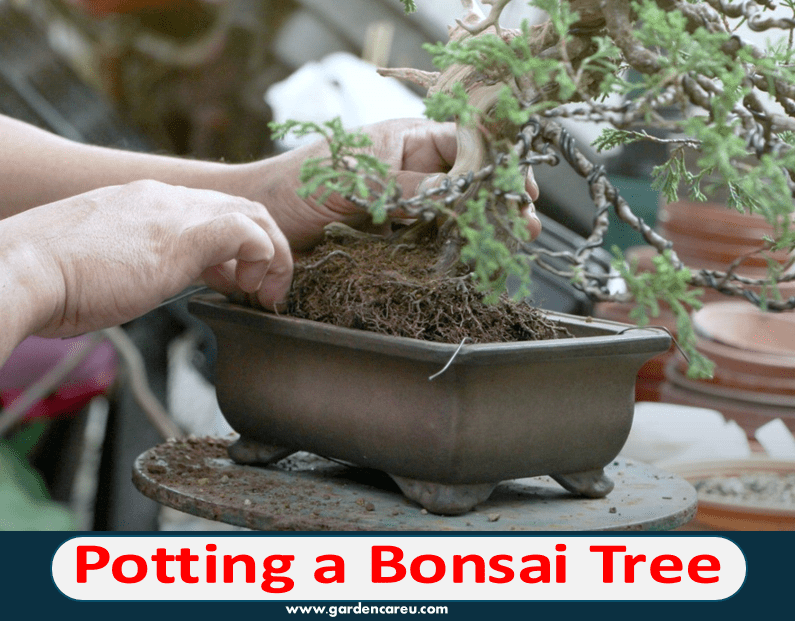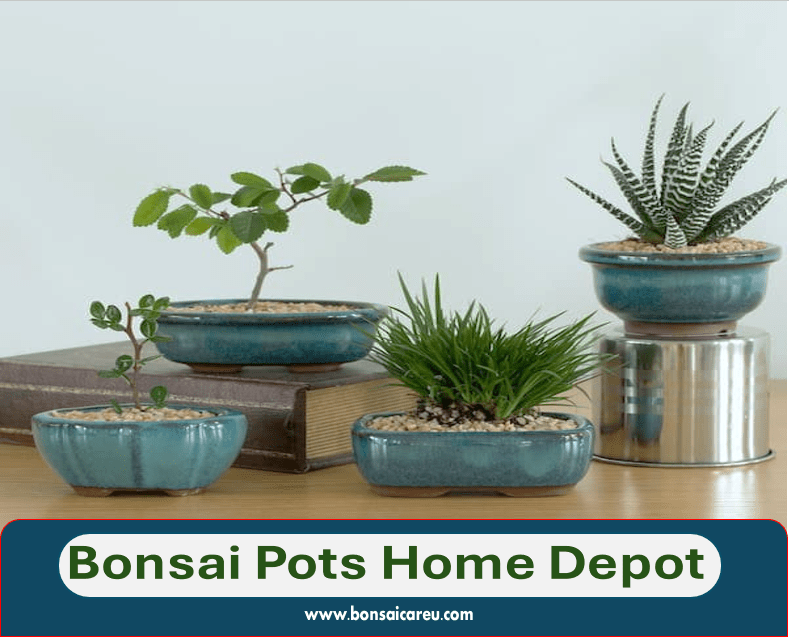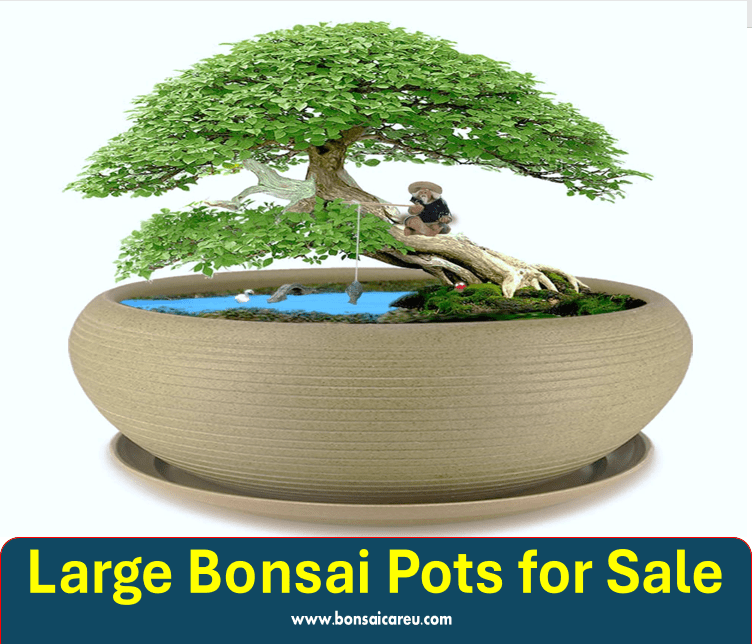Potting a Bonsai Tree: Pot a bonsai tree by carefully repotting it with the appropriate soil mixture and securely tying it down. This process ensures healthy root growth and overall tree vitality.
Properly potting a bonsai tree is essential for its health and longevity. Understanding when and how to report and choose the right soil mix and pot is crucial in maintaining a thriving bonsai. Following the correct techniques and materials can promote strong root development and support the tree’s growth.
This guide will dive deeper into the steps involved in potting a bonsai tree, ensuring it thrives in its new environment. Let’s explore the intricacies of potting a bonsai tree to cultivate a stunning and healthy miniature masterpiece.

Choosing The Right Time To Repot
Choosing the right time to repot a bonsai tree is crucial for its health and growth. Evaluating if repotting is necessary, removing the old soil, root pruning, and soil layering are essential steps. Learn more about repotting techniques from expert tutorials and ensure your bonsai thrives in its new pot.
Bonsai trees require repotting to maintain their health and vigor. Knowing the right time to repot your bonsai is crucial for its well-being. By understanding the signs that indicate the need for repotting and the optimal season for the process, you can ensure your bonsai thrives.
Signs That Your Bonsai Tree Needs Repotting
- Roots circling the root ball
- Slow growth or stunted development
- Water draining too quickly from the pot
Optimal Season For Repotting
Early spring, before new growth begins, is the best time to repot a bonsai tree. This period allows the tree to recover quickly and adjust to its new environment. Avoid repotting during the winter dormancy or in the middle of summer when the tree is actively growing.
Preparing The Bonsai Tree For Repotting
To prepare a bonsai tree for repotting, gently loosen the root ball and trim any overly long roots. Carefully select a suitable pot with proper drainage holes. Repot using well-draining bonsai soil to ensure optimal growth and health of your bonsai tree.
Gathering Necessary Tools And Materials
Before starting the repotting process, gathering all the necessary tools and materials is essential. Here are the items you will need:
- Bonsai pruning shears
- Bonsai wire (for securing the tree in the pot)
- A small piece of mesh or screen to cover the drainage holes
- A new pot that is suitable for your bonsai tree’s size
- Bonsai soil mixture (recommended mixtures consist of Akadama, Pumice, and Lava rock)
- A chopstick or small tool for working the soil around the roots
Assessing The Health Of The Bonsai Roots
One crucial step in preparing the bonsai tree for repotting is assessing the health of its roots. Healthy roots are vital for the overall well-being of the tree. Here’s what you should do:
- Gently remove the bonsai tree from its current pot.
- Examine the roots for any signs of overcrowding, rot, or disease.
- If you notice any dead or decaying roots, carefully trim them with the bonsai pruning shears.
- Look for a healthy white color in the roots, which indicates good vitality.
- If the roots are extremely tangled or circling the pot, it might be necessary to perform root pruning during repotting.
Assessing the health of the bonsai roots can ensure that the tree has a strong foundation for future growth.
Mastering The Repotting Process
Through practical tutorials, discover the essential steps for potting a bonsai tree and mastering the repotting process. Learn how to evaluate repotting needs, remove old soil, prune roots, and layer soil effectively. Upgrade your skills with insightful videos and expert guidance, ensuring your bonsai thrives in its new environment.
Removing The Bonsai Tree From Its Current Pot
Before repotting your bonsai tree, it is crucial to remove it from its current pot carefully. Start by gently tapping the sides of the pot to loosen the tree’s root system. Once loosened, slowly slide the tree out, supporting the base with your hand or a small shovel. Be careful not to damage the fragile roots during this process.
Pruning And Trimming The Roots
After removing the tree from its pot, it’s time to prune and trim the roots. Use sharp bonsai scissors or shears to remove any dead or tangled roots. Trim back long roots, maintaining a balanced root system. This pruning process ensures the tree’s roots can properly absorb nutrients and water once replanted.
Choosing The Right Soil Mixture
Choosing the right soil mixture is essential for your bonsai tree’s overall health and growth. Two recommended soil mixtures are Akadama and Pumice. Akadama provides excellent water retention, while Pumice offers a good substrate structure. A suitable mixture would consist of a blend of 70% Akadama and 30% Pumice. This combination allows for proper drainage and aeration, promoting root development.
Replanting The Bonsai Tree
Now it’s time to replant your bonsai tree in its new pot. Select a pot suitable for your tree’s size and style. Start by placing a piece of mesh over the drainage holes to prevent soil from escaping. Carefully position the tree in the pot, ensuring it sits slightly off-center for aesthetic purposes. Gradually add the bonsai soil mixture around the roots, using a chopstick to work the soil and fill any air pockets gently. Ensure that the roots are well-covered and supported.
Understanding Bonsai Soil Mixtures
Understanding the soil mixture’s importance is crucial to successfully potting a bonsai tree. The right combination of components can greatly impact the growth and health of your tree. Let’s delve deeper into the world of bonsai soil mixtures.
Components Of A Recommended Bonsai Soil Mix
- Akadama: Retains water effectively
- Pumice: Provides good substrate structure
- Lava rock: Enhances aeration and drainage
Adapting Mixtures To Different Circumstances
Depending on the specific needs of your bonsai tree, you may need to adapt the soil mixture accordingly. Consider factors like the type of tree, climate, and watering habits when customizing the soil mix.
Selecting The Ideal Bonsai Pot
When potting a bonsai tree, selecting the right pot is crucial for its overall health and appearance. The ideal pot should complement the tree’s aesthetic and provide ample space for root growth and proper drainage. When choosing the perfect pot for your beloved bonsai, let’s dive into the essential factors.
Materials For Bonsai Pots
Bonsai pots are typically crafted from various materials, each offering unique benefits. Common materials include ceramic, clay, and plastic. Ceramic and clay pots are favored for their aesthetic appeal and breathability, while plastic pots are lightweight and convenient.
Considerations For Choosing The Right Pot
When selecting a bonsai pot, several crucial factors come into play. It’s essential to consider the size of the pot, ensuring it provides sufficient space for the tree’s roots and promotes healthy growth. Additionally, evaluating the shape and color of the pot is important, as it should harmonize with the bonsai tree’s overall design.
The drainage capability of the pot is another vital consideration. Proper drainage is essential to prevent waterlogging, which can lead to root rot. Additionally, the material of the pot plays a role in water retention, with clay and ceramic pots allowing for better airflow and moisture regulation compared to plastic pots.
Lastly, the pot’s durability and weight should be taken into account. A well-constructed, sturdy pot will provide long-term support for the bonsai tree, while the pot’s weight can affect stability and portability, especially for larger bonsai specimens.
Recognizing When Your Bonsai Tree Needs Repotting
Recognizing when your bonsai tree needs repotting is crucial for the health and growth of your plant. Over time, the roots of a bonsai tree can become pot-bound, leading to reduced water and nutrient uptake. Understanding the signs that indicate the need for repotting allows you to provide the best environment for your bonsai to thrive.
Indications Of A Pot-bound Bonsai Tree
A pot-bound bonsai tree may exhibit several signs that indicate it’s time for repotting. One indication is circling or protruding roots at the pot’s bottom drainage holes. In addition, if you notice a significant decline in growth, with slow or stunted development, it could be a sign that the roots have filled the container and the plant needs a new space to grow. Despite proper care, yellow leaves or wilting can signal that the bonsai is pot-bound and requires repotting to rejuvenate its growth.
Other Signs Requiring Repotting
Other signs may necessitate repotting your bonsai tree. If the soil remains wet for an extended period after watering, it might indicate that the root system isn’t functioning efficiently, and the plant needs a new pot with fresh, well-draining soil. Unpleasant odors emanating from the potting mixture can also indicate root rot or other detrimental conditions, requiring immediate repotting to ensure the bonsai tree’s health.

Frequently Asked Questions
What Kind Of Potting Soil Does A Bonsai Tree Need?
Bonsai trees need well-draining soil with a mix of Akadama, Pumice, and Lava rock for water retention, good substrate structure, aeration, and drainage.
Do Bonsai Trees Need Special Pots?
Yes, Bonsai trees need special pots, usually made of ceramic or porcelain, and stoneware burned for water absorption.
How Do You Know When To Repot A Bonsai Tree?
To know when to repot a bonsai tree, lift it gently and check for pot-bound roots. Report if roots encase the soil.
Do Bonsai Trees Like To Be Root Bound?
Bonsai trees do not like to be root-bound. When the roots encircle the bottom of the pot, they must be repotted.
Can I Repot My Bonsai Tree?
You can repot your bonsai tree to ensure its health and proper growth.
When Should I Repot My Bonsai Tree?
It is recommended that your bonsai tree be repotted every 1-3 years, depending on its age and the condition of its root system.
Conclusion
Proper repotting ensures a healthy bonsai tree. Root pruning, soil layering, and careful handling are crucial steps. Learn from experts and videos for successful bonsai care. Remember to choose the right pot and soil mixture for your bonsai’s well-being. Happy potting!


